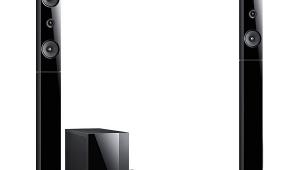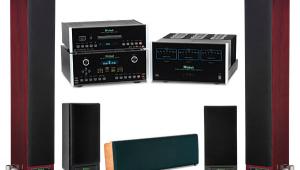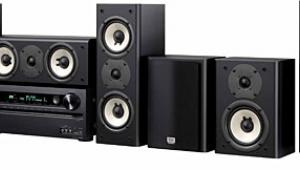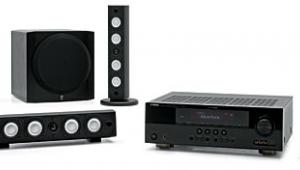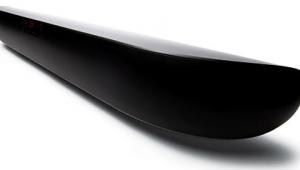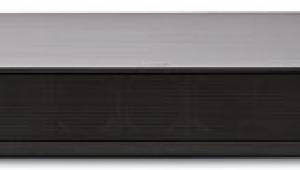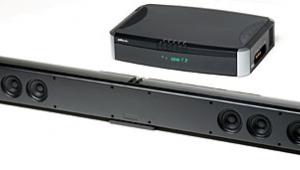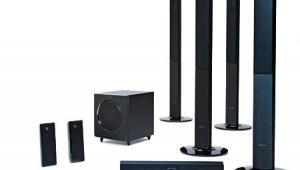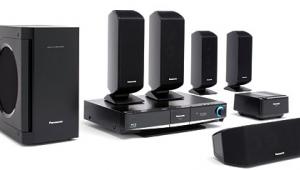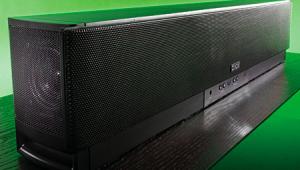KEF HTF8003 Soundbar Speaker System
Slim Bar, Wireless Sub
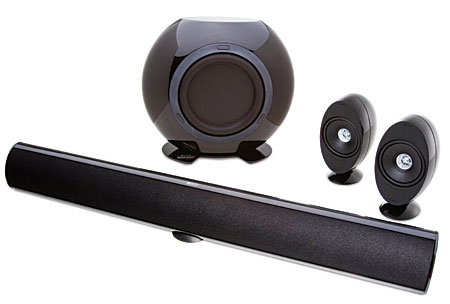
It goes without saying that the soundbar and satellite/subwoofer categories have grown in stature along with the overwhelming popularity of flat-panel displays. As those displays have become rigorously slimmer, their skinny bezels have provided less room for speakers—not just home-theater-worthy speakers, but even something adequate for watching the news. Thus, it’s created a desperate urgency for a flat-panel-friendly audio solution.
I’m not just pulling this thesis out of my ear. This is my own life I’m talking about. I recently replaced one LCD HDTV with another. My old set had big metal speaker grilles on either side of the screen. While it wasn’t a home-theater-worthy audio solution, the built-in speakers were good specimens of their kind. They were more than adequate for talking-heads telly. But the new TV replaced the old one’s big side-mounted speakers with smaller ones at the rear of the enclosure.
I love my new TV’s LED backlighting and 1080p resolution, but I couldn’t get through a single evening with its tiny, poorly situated, bad-sounding speakers, even for casual TV viewing. In desperation, I hooked up a pair of powered PC speakers. (Of course, I still use my reference surround system’s heavier artillery for movies and concert videos.)
Now I greet every soundbar product that comes through the door as a potential conquering hero, or at least a welcome guest.
The Bar, the Sats, the Sub
KEF’s HTF8003 soundbar is my latest guest. This is a threechannel soundbar with speaker terminals, but it doesn’t have a built-in amp or surround processing. I reviewed it in conjunction with a pair of HTS3001SE satellites for the surround channels plus an HTB2SE-W wireless subwoofer. All of the enclosures are made of heavy aluminum with a gloss-black finish. They are impressively solid and likely less subject to resonance in the critical vocal region than many plastic enclosures. When I performed the knuckle-rap test, I found that the satellite was especially good in this regard. In fact, a system based entirely on this speaker and a sub might sound pretty good.
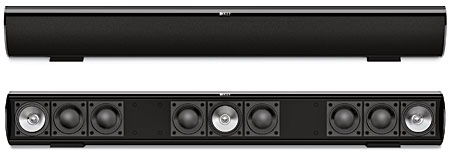
The soundbar measures just under 38 inches wide, which is about the width of a 42-inch flat-panel HDTV. I placed it on the table that holds my TV using the supplied rubber rocker pieces. I aimed the soundbar slightly upward, toward the seating position. (KEF also supplies wall-mount hardware.) Although it’s less than 5 inches tall, the soundbar’s top edge obscured my TV’s infrared sensor unless I stuck my arm in the air and aimed the remote down. It would be better to elevate the TV a couple of inches. Of course, any other soundbar would have done the same thing, and with a wall mount, the sensor wouldn’t be blocked.

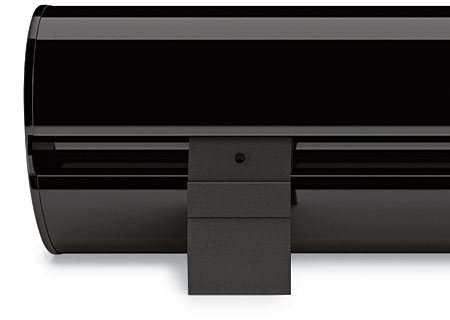
The HTF8003 covers each of its three channels with three drivers, including a 3-inch woofer and 0.6-inch tweeter arranged in a coaxial Uni-Q array. In other words, the tweeter sits inside the bottom (or apex) of the woofer’s cone, and they act similar to a point source. They fire their separate signals at exactly the same spot in the seating area and at almost the same time. KEF has been doing this for a long time. It keeps response controlled and relatively consistent over a broad, symmetrical listening area, and it’s potentially a great way to tighten up imaging. A 3-inch passive bass radiator and an aluminum disc coated with compression-molded rubber further reinforces each channel. However, this driver isn’t part of the coaxial array. Instead, it’s located adjacent to each Uni-Q. Each speaker terminal is a spring-loaded cylinder that’s a bit like a binding post mated with a wire clip. The holes in these posts were a little too narrow for my usual 12-gauge cable, so I used a skinnier 18-gauge.
The HTS3001SE satellite, which I used as a surround, is an egg-shaped speaker that sits atop a metal pedestal in a matching gloss-black finish. You can use the supplied Allen wrench to adjust the hinged pedestal. Driver materials match those in the soundbar, but the drivers are slightly larger. They include a 4-inch woofer and a 0.75-inch tweeter. Speaker terminals are sturdy bullet-shaped binding posts. Just above them is a back port that’s plugged with removable foam. KEF recommends that you only remove it if you use the HTS3001SE without a subwoofer.
The HTB2SE-W subwoofer has the same rounded form as KEF’s other subs. From the front, it looks like a wheel with the top lopped off. Although it’s more than 15 inches tall, it’s less than 8 inches deep, so you can put it next to a wall and it won’t intrude much into the room. The 10-inch active driver on the front is complemented by a 10-inch passive radiator, made of rubber-coated aluminum, on the back. Controls are on the bottom, so I had to roll the sub onto its side to access them. There’s no continuously adjustable volume knob. Instead, the sub provides a three-position Bass Boost switch that adjusts output around a claimed 40 hertz by 0, +6, or +12 decibels. If you want to make further adjustments, you must make them in your surround processor. The sub also has a phase control and a switch that toggles between wired or wireless operation.
